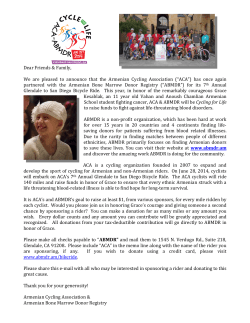
Document 9593
CLIN. CHEM. 30/2, 238-242 (1984)
Determination of Creatine Kinase MB Activity with the Du Pont aca:
Interferences from the Sample Matrix
Wolfgang
Stein
and
JUrgen Bohner
During the last three years we and others have observed
discrepancies
between results for creatine kinase isoenzyme
MB as measured with the mechanized ion-exchange chromatographicmethod in the Du Pont aca and those by other
techniques.These observationsprompted us to investigate
the influence of the matrix on the Du Pont CK-MB assay. We
conclude that, apart from possible interferences by CK-MM,
CK-BB, and both types of macro CK, the aca will give
apparent CK-MB activities that are directly related to protein
concentration and inversely related to sodium chloride concentration. Practical consequences for the routine and emergency laboratories are: no diluted samples are allowed;
application is restricted to samples from patients suspected
of acute myocardial infarction which show upper-normal total
CK activity; and multiple timed samples are run, in order to
recognize
the typical change
in enzyme
pattern
with time.
AddItIonal Keyphrases: isoenzymes
macro creatine kinase
myocardial infarction
ion-exchange chromatography
immunoinhibition
CK-MB’ activity is widely determined,
to help confirm or
rule out acute myocardial
infarction.
During recent years
different
methods
have been developed,
several
modifications of which are now commercially
available, the suppliers
claiming
sensitive
and specific measurement
of the MB
isoenzyme.
However, none of these methods can be regarded
as ideal with respect to specificity, sensitivity,
handling,
and
low test cost.
Our first evaluation
of the Du Pont procedure for the aca
discrete analyzer (1) revealed
that the coefficient of correlation (r) between the results from the aca and the immunoinhibition method was only 0.89, even if sera containing
CKBB or macro CK (2, 3) are excluded. Similar results have
recently been reported (4,5). In further studies the diagnostic performance
of the aca assay was most often evaluated
in
comparison with isoenzyme electrophoresis
(6-12). In four of
these studies (6, 8-10) electrophoresis
yielded better results
with respect to diagnosis of acute myocardial
infarction.
In
the remaining three studies the aca assay proved to be quite
equivalent
to (7, 12) or better than (11) electrophoresis.
A
more detailed
analysis of the reported results shows that,
depending on the prevalence of myocardial
infarction in the
population
studied and on the mode of sampling
(multiple
timed samples or not), the values for the diagnostic efficiency varied markedly:
pp
ranged from 0.85 (7) to 0.95 (11),
Medizinische Universitatsklinik
TUbingen, Abteilung IV, D-7400
Tubingen, F.R.G.
‘Nonstandard
abbreviations:
CK, creatine kinase (EC 2.7.3.2,
ATP:creatine N-phosphotransferase);
CK-MM, CK-MB, and CKBB; skeletal muscle, heart, and brain types of cytoplasmic CK
isoenzymes; INH, immunoinhibition
method for CK-MB; URL,
upper reference !imit; pp,,,, and pp,,,
posterior probability of the
positive and negative results, respectively.
Received April 25, 1983; accepted October 25, 1983.
Ed. note: See pp 34 1-342 for a response from a spokesman for Du
Pont.
238 CLINICAL CHEMISTRY,Vol. 30, No.
2, 1984
PPneg from 0.88 (8) to 0.98 (11), whereas
ity ranged between 0.82 (8) and 0.98
between 0.50 (10) and 0.96 (11).
diagnostic
sensitiv(11) and specificity
The occurrence of discrepancies between the aca and other
methods for CK-MB prompted us to start a new and more
detailed evaluation. In this series of experiments we primarily focused on analytical recovery of CK-MB from the aca
column as a function of ionic strength, pH, and total protein
concentration
of the samples. We also studied the effect on
the aca CK-MB assay of CK-MM and its post-synthetic
variants (13-15) as well as of the macro creatine
kinases
(2,3).
Unfortunately,
there is no general agreement on a reference method for CK-MB. As comparison
methods we therefore used isoenzyme
electrophoresis
to qualitatively
check
the isoenzyme composition
or purity of the samples, a
commercially available immunoinhibition
method (16) and,
as far as possible, the total CK assay to quantitatively
determine enzyme activities.
Our aim was to explain some of the discrepancies
described in the earlier studies and to show why the sensitivity
and specificity of the aca assay are sample dependent. To
minimize interferences
and problems with the interpretation of the results we recommend a stepwise strategy for use
of the aca CK-MB method in the routine and emergency
laboratory.
This strategy accords with the recommendations
(17, 18) for verification
and ruling out of the diagnosis
“acute
myocardial
infarction”
by the immunoinhibition
method.
Materials and Methods
Samples:
Serum
samples
were either
analyzed
on the
same day or stored at 4 #{176}C
for not more than 24 h or at
-20 #{176}C
without any additives until the day of the assay.
Macro creatine kinase was detected and differentiated
into
both types as described
elsewhere (2,3). CK-MM and CKMB were prepared from human tissues as previously described (19). Contamination
of the CK-MB preparation with
CK-MM was <5%, as checked by electrophoresis
(3). CKMM showed no (<2%) CK-MB contamination
detectable
by
electrophoresis,
and it was inhibited by anti-CK-M antibodies by >99%. Furthermore,
we checked the purity of the
isoenzyzne
preparations
and the distribution
of the postsynthetic CK-MM variants in human serum by isoelectric
focusing in agarose gel (pH range: 5-8) according to the
manufacturer’s
instructions
(LKB Produkter,
Bromma,
Sweden). At the end of each run, CK activity was made
visible by overlaying the agarose plates with filter paper
(soaked with CK reagent)
for 1 h at 37 #{176}C.
The presence of
adenylate kinase (EC 2.7.4.3) was excluded in additional
runs by observing the results of overlaying the plates with
reagents lacking the creatine phosphate substrate.
Enzyme assays: Total CK activity of 100-L samples was
determined
at 37 #{176}C
in the aca II and aca ifi (Du Pont,
Wilmington,
DE) (20) and also by using reagents containing
N-acetylcysteine
(21) (E. Merck, Darmstadt,
F.R.G.) in an
ACP 5040 instrument
(Eppendorf
Ger#{228}tebau,Hamburg,
F.R.G.). CK-MB was determined at 37#{176}C
in both the aca
(20) and by the immunoinhibitionmethod (INH).The reagents were suppliedby E. Merck, Darmstadt,
and BoehringerMannheim,
Mannheim, F.R.G. For the assays run in
the ACP 5040 instrument
(2), the results were corrected for
blanks and adenylatekinase.
Calibration
of the aca:We checked the calibration
ofboth
instruments
with Du Pont CK-MB verifiers (lots 1979 N,
0JD125, 9GD106, 2AD102, and 1JD155) accordingto the
supplier’s instructions.
Our values for scale factor and the
linearterm C1,as wellas for the starting point and offset
term c0 were at or very near the assigned values for both
instruments.
This was the case not only forthe original
version of calibration
(20a)-scale
factor: 0.6068; c1 term:
12.14;starting point and c0offset:
0-but alsoforthe revised
procedure-scale
factor:
0.8422;c1 term: 16.84;starting
pointand c0 offset:
0 (20b, 22). The revisedprocedurefor
calibrating was introduced to us by Du Pont in September
1982,accordingtowhich the scalefactorofthe instrument
and the assignedvaluesforthe CK-MB verifiers
level2 had
to be increasedby a factorof 1.388.Re-evaluationof the
recovery of CK-MB in the aca assay made this modification
necessary;
the method itself remained unchanged (22).
For the sake of clarity, all results reported here were
either directly determined
according to the revised procedure or were transformed
by linear regression to correspond
to this revised procedure. The lot numbers of the CK-MB
.CK
0’
0’2
UN
HOE
GRU
ow
006
#{176}0
TPI9/1j
2
3
05
67
03
07
05
05
07
03
0
0)
06
Fig. 1. Effect of dilution on the
05
03
0
CK-MB activity in
07
27
0
05
05
07
03
SERI.
0t06N’
0
samples of patients
with acute myocardial infarction
Sera of patients LIN. (total CK: 1056 U/L), HOF. (total CK: 320 U/L), and GRU.
(total CK: 444 U/L) were diluted withsodium chloride solution (154 mmot/L).
#{149}
#{149}
#{149}:
rel.CK = CK-MB(aca)/total CK. x-x-x:
rel.CK = CK-MB(INH)/total
CK. If there were no matrix effect, a horizontal linewould be expected
material.In some casesthe sera were concentratedin an
Amicon A 25 or B 15 concentrator(Amicon GmbH, Witten,
F.R.G.)to increase protein concentration
by twofold.
Total protein was determined in the aca, sodium concen-
MB are dilutedsimultaneously
and to the same degree.In
contrast
to immunoinhibition,the aca reports a decreasing
fraction
ofCK-MB, which isdirectly
relatedtothedegreeof
dilutionof the serum. This decreasein apparent CK-MB
activityisthe resultofsome interacting
effects
on the aca
method:
1. Sodium
chloride concentration:
dilution
of the matrix
with sodium chloride solution not only dilutes the analytes,
it also changes the concentrations
of anions and cations that
may influencethe analytical
recoveryofCK-MB.
2. CK-MM
and CK variants:
CK-MB activityas measured in the aca is biased by the activity of CK-MM (20) and
macro CK (1, 4) in the sample.Dilutionofthe sample may
alterthe ratesof interference
ofthesecreatinekinases.
3. Protein
concentration:
Serum proteins,which may
compete with CK-MB and CK-MM forbindingplaceson the
column, may influencethe retentionratesof both isoenzymes ifthe totalproteinconcentrationof the serum is
altered.
To evaluatethe relativeimportance of these individual
tration
factors,
packs
used were:
B 9248 A, B 9138 B, B 0283 A, B 1281 A,
and C 1313 A.
Dilution
of isoenzymes:
The isoenzyme stock solutions
were appropriately
diluted with imidazolebuffer(E.Merck,
no.14109,pH 6.7,100 mmolfL), bovineserum albumin (Du
Pont Enzyme Diluent, 66 gIL), normal serum, heat-inactivated serum (1 h at 56#{176}C),
sodium chloride solution (1 molI
L, 154 mmol/L),
or Du Pont CK-MB verifier level 1. This
“verifier” is a serum-based material (total CK 0 U/L, Na <5
mmol/L, K <0.3 mmol/L, total protein 60 g/L, pH 6.9-7.1,
Pco,
1-2
mmHg),
was
which
measured
is to serve
in a Nova
as a quality-control
1 instrument
(Nova
Bio-
medical
GmbH, Darmstadt,
F.R.G.), and the pH was controlled in every sample with an AVL blood-gas
analyzer
(Model 937; AVL GmbH, Schafihausen,
Switzerland)
at
37 #{176}C.
Accuracy and precisionof the enzyme assays were
checked with commercial
control sera: Monitrol I and II
(AHS Deutschland,Munchen, F.R.G.),Precinorm
U (Boehringer Mannheim),
and Seronorm CK-MB (E.Merck).
which
together
cause the observed
decrease
we undertook
the following
series
In these
studies
we tried to keep as
of the samples
constant
as possible,
to
CK-MB activity,
periments.
constituents
in the
of exmany
avoid
interferences
by CK-MM, and we adjustedthe CK-MB
activity
to such a high levelthat imprecisionofthe assays
became a negligible
consideration.
Sodium ChlorideConcentration
Results and Discussion
Dilution
of Serum
Samples
Spectrophotometric
determinations
of enzyme activity are
sometimes disturbed by lipemia, gross hemolysis, very high
enzyme activity,
or shortage
of sample in cases when the
requiredsample volume is rather high (340 ML, e.g.,is
needed forthe aca CK-MB determination).
Although often
not recommended, samples thus are often dilutedwith
variousdiluentsbeforevarious assays, because the accuracy
ofmost assaysisonlyveryslightly affected and theobserved
deviations are far from clinical significance. In contrast, we
can demonstrate
a remarkable
influence of dilution on the
aca CK-MB assay.Figure 1 shows the effect of dilution with
154 mmolJL sodium chloride solution on the apparent CKMB activityin the sera of threepatientswho had had an
acute myocardial infarction. The quotient CK-MB/total CK
shouldnotbe affected by dilution, because total CK and CK-
Figure
2 illustrates
the
concentration
in the sample
influence
of sodium
on CK-MB activity
chloride
as deter-
mined by each assay. It shows relativeCK activities,
corrected for the different analytical recovery for each assay.
With ion-exchangers,
protein elution usually increases with
increasing
ionic strength
of samples
and buffers. Here we
also find a distinct influence
of the sodium chloride concentration
on the CK-MB activity
but, in contrast
to common
experience,
the values
decrease
with
increasing
ionic
strength of the sample. In our hospital,sodium chloride
concentration
ofemergency samples rangesfrom 123 to 156
mmol/L
(95% percentile,
n = 3606). Such variations
in
sodium chloride concentration
in a human serum significantly (± 10%) affect the accuracy of the aca C K-MB method
but not of the INH assay.
At low CK-MB
activities
and at
CK-MB activities near the decision limit (2.2% of total CK)
this influence of sodium chloride may diminish the diagnostic efficiency of the aca method.
CLINICAL
CHEMISTRY,
Vol. 30, No. 2, 1984
239
rel.CK
A
+
1.4-
iooo lu/LI
CK-I#{128}
1000 13.1/LI 3.2
31
500I
URLIIM.q.”
200
‘
500
200
00
soy
50
20
S
1,2-
073
S
2357020
SOW
iCKIU/LI .E
071
2357020
SOW
ICKIUILI
-2
Fig. 3. Effectof CK-MM on the CK-MB methods
1: Fresh normal serum (total CK: 77 U/L total protein: 76 g/L, pH: 8.0) was
supplementedwith human CK-MM.
2: Fresh serum from a patient suffenng from myositis(total CK: 10800 UIL,
totalprotein:7.2 g/L, PH: 7.9, CK-MB: positive in electrophoresis and about 2% of
total CK in INH) was diluted with a fresh normal serum (total CK: 37 UIL, no CK-
1.0
MBdetectable).
#{149}
#{149}
#{149}:
CK-MB(aca).x-x-x: CK-MB(INH).URL:aca: 0610U/L or 062.2%
of total CK, if total Ct( >450 U/L. INH: 0624 U/I or a6% of total CK, if total CK
>400 U/I.
0.8’
S
0.6
S
NaCIfrnmoI/L)
50
100
150
200
Fig. 2. Dependence
of CK-MB actMties on the sodium chloride
concentrations of the matrix
CK-MB stock solution, diluted with inactivated human
or CK-MB verifier
level 2 were supplemented with 1 mol/L sodium chloride
to give appropriate
concentrationsof NaCI but to hold CK activity,total protein, and pH constant. yaxis: relative CK activity
(CK activityat 140mmol/Lsodiumchloridewas set 1.0).
#{149}
#{149}
#{149}:
CK-MB activity(aca):
serum, total CK: 330 U/L, total protein:70 g/L,
pH: 7.9. +-+-+:
CK-MBactivity(aca):
verifier
level2. x-x-x:
CK-MB activity
(INH): serum, total CK: 330 U/L, totalprotein:70 gIl, PH: 7.9. Dashed lines: 95%
range of sodiumconcentrationin the emergency samples of our laboratory
serum
Hemolysis,Bilirubin, and pH
Neither
sample
pH values between
6.9 and 8.5, hemoglo-
bin concentrations
up to 17.5 gIL, nor bilirubin
concentrations up to 350 Mmol/L affected either the aca CK-MB assay
or the INH, if performed as described
(2) (results not shown).
CreatineKinase MM
Figure
3.1 shows
results
obtained
for a normal
serum
with increasing
amounts
of human CK-MM.
In contrastto INH, the apparent CK-MB activityby aca
increases and exceeds its URL (20) at CK-MM activities of
about 300 U/L. Though no CK activity
otherthan CK-MM
was detectable during electrophoresis
and <0.7% by INH
[Figure 3.1: 67 (UIL INH)/10 000 (U/L total CK) = 0.0067]
the aca reported
about 4% apparent CK-MB. Itis rather
unlikely that these unexpected
aca results are caused by
postsynthetic
variants
of CK-MM-CK-MM1,
CK-MM2,
CK-MM3 (13-15)---because
isoelectric
focusing of the concentrated
eluatesobtainedfrom the aca columns showed the
passage
of allthree variants.However, we cannot totally
excludethe possibility
thatpostsynthetically
modifiedCKMM may differslightlyin itsdegree of retentionon the
column. If the modification of CK-MM in the serum results
in decreased
retention on the column used in the aca then
the apparent CK-MB activities will increase. Even if total
CK concentration
is still normal,
the CK-MM interference
is
supplemented
240
CLINICAL CHEMISTRY,Vol. 30, No. 2, 1984
already
observable.
Figure 3.2 demonstrates
that after
dilution of serum from a patient
with myositis,
containing
about 2% CK-MB by INH and electrophoresis,
with normal
serum containing
no detectable
CK-MB,
the fraction
of
apparent
CK-MB by aca changes from 6% to 2%, indicating
that the matrix of this particular
serum is influencing
the
rate of retention
of CK-MM.
Recovery of CK-MB inPatients’
Samples
During our first evaluationofthe aca CK-MB method (1)
we tried to recalibrate the aca to make values agree with
thoseby the INH method at 25 #{176}C.
Regressionanalysisfor
94 sera yielded the following results: y(aca, 37 #{176}C)
=
3.3 +
1.4x(INH, 25 #{176}C),
r = 0.89. Recently the energy of activation
of CK-MB was determined to be 58 kjlmol (23) in the
backward reaction.
This value isequivalentto a temperature conversion
factor of 2.5 for CK-MB and a temperature
interval from 25 #{176}C
to 37 #{176}C.
The theoretical
slope of the
regression line showing the correlation
between the aca
(37 #{176}C)
and the INH (25 #{176}C)
results should be equal in value
to the temperature
conversion
factor. The results obtained
in this split-sample
study,
however,
indicated
that the
recovery of CK-MB (aca) is 1.412.5, or 0.56, if the aca is
calibrated
accordingtotheoriginalversionand is0.78ifthe
aca is calibrated
according
to the revised procedure.
Inciden-
tally,similarcorrelation
studieswith samples containing
CK-MM
and total CK as measured in the aca and the
method accordingto ref. 21 showed no such differencestheoretical and experimental
scale factors are almost identical.Furthermore,the slopesof correlation
curvesrelating
the INH and manual chromatographic
systems did not
deviateby more than 10% from 1.0(5, 24), indicating good
agreement.
Recovery and Linearity
of CK-MB and CK-MM
VariousMatrices
in
We investigated
the effects of sodium chloride, bovine
serum albumin, normal serum (fresh and inactivated), and
CK-MB verifier level 1 on assay results. lithe CK-MB stock
solution is diluted with sodium chloride (154 mmolIL, protein free) or bovine serum albumin (Enzyme Diluent) CKMB activityistotallyretainedby the column and the aca
therefore reports 0 U/L of CK-MB activity (Figures 4.1, 4.2).
Dilutionwith normal human serum yielded better results
St
012
‘S
‘S
030
‘0
‘0
05
0
OL
0
TPI5/tj
U/L
Fig. 5. Analytical
330
/
)
recovery
“U’
50
SO
0
4.0
SO
TP3gJLI
160
IPIg/LI
of CK-MB and CM-MM as a function of the
protein concentration of the matrix
Equal amountsof CK-MB (Fig. 5.1 and 5.2) and CK-MM (Fig. 5.3) were added to
the appropriatelydiluted (with NaCI solution 154 mmol/L,pH 7.0) matrices. CKMB activity (Fig. 5.1 and5.2) was 550 U/L. CK-MM activity (Fig. 5.3)was 5500 U’
L Matrices:inactivatedserum (pH 8.2): Fig. 5.1. CK-MB verifier
level1 (pH 6.9):
Fig. 5.2. normal serum (fresh, concentrated, pH 8.2): Fig.5.3.
x-axis: total proteinconcentrationsof the samples. y-axis: relative CK activity =
264
198
132
apparent CK-MB/total CI<
#{149}
S 5: relativeCK(aca). x-x-x-:
relative CK(INH). Dashed lines: 95%
range for total protein for our hospitalizedpatients
0
66
132
198
264
330
U/L
the protein
concentration,
because
the applied
CK-MB
ac-
tivitywas kept constant.Though bothmatrices(inactivated
serum and CK-MB verifier
level1)differso much in their
ratesofrecovery of the applied CK-MB activity (Figures 4.3
and 4.5),the relativeincreaseofthe CK-MB activity with
increasing protein concentration
is almost coincident (Figures 5.1 and 5.2) and agrees well with the results presented
in Figure
1. In our hospital,
total
protein
concentrations
for
95% of all patientsfallbetween 50 and 85 g/L. Such
fluctuations
52
104
156 207 260
ti/L
Fig. 4. Unearity and recovery of CK-MB in different matrices
x-axis: CK-MB (U/I) added to the matrix. y-axis: CK activity, recovered as total
CK or CK-MB(U/I).
- S 5: CK-MB (aca) activity.
x-x-x:
CK-MB (INH) activity. A-A-A:
total
CK activity.
Slopesb were calculatedby regression analysis.
1: Matrix: sodium chloride (154 mmoLfL). Recovery: aca: b&bA = 0.0
2: Matrix: bovine serum albumin (total protein 66 g/L, pH 6.9). Recovery: aca:
be/bA = 0.0
3: Matrix:inactivatedserum (totalprotein 82 g/L, pH8.3).Aecovety:ace: be/
bA 0.42
4: Matrix: fresh normal serum (totalCK 135 U/I, total protein 74 g/L). Notice:
total CK is the sum of endogenousCK-MM and added CK-MB.Recovery:
ace: bbA
=
0.63 Recovery:ace: b./b4.= 0.67.
5: Matrix:
CK-MBverifier level 1 (total protein 60 gIL pH 7.0). Recovery:ace:
b/b1,
=
1.32.
Unearity was excellent in all cases with a recovery >0
(Figures
4.3,4.4),
but the recoveryforCK-MB inthesecases
obviously was still too low. Furthermore,
we observed
differences
between freshand inactivated
human
serum,
which apparently
are a sign of a special matrix effectof
unknown
cause.After dilutionofthe CK-MB stock solution
withtheCK-MB verifier,
which contains no CK activity and
shows extremely
low concentrations
of sodium and C02, the
results for linearity
the CK-MB assays
demonstrated
good agreement
between
(Figure 4.5), but we found paradoxically
high values (132%) for recovery.The reason for these
differences
in recovery rates between serum and verifier
is
not fully understood.
Itisat leastpartly ascribable
to the
different
sodium chloride concentrations
in the two matrices.
Additionalexperiments
(Figure 5) showed that not only
the type of matrix but also theconcentration
oftotalprotein
is important
for recovery of CK-MB from the column.
During this series we mainly investigated
the influenceof
in serum
protein
concentration
may alone
be
responsible for twofold differences in apparent CK-MB (aca)
activities. The overall effect observed in patients’ sera is still
more complex, because the retentionof CK-MM
on the
column shows an additionaland distinct
dependence on the
proteinconcentrationofthe sample (Figure5.3).
These resultsclearlyshow thatthe activity
ofCK-MB as
measured
with the aca is highly influenced by protein
concentration,
by CK-MM activity,
and, to a lesser degree,
by sodium concentration.
With increasingNaCl and decreasingprotein and CK-MM concentrations
the aca results
decrease more and more and finally reachzero.Even ifonly
physiological
concentrations
forproteinand NaCl are taken
intoconsideration,
theCK-MB activities
reported by the aca
still
may differ
widely.
Characteristic
Enzyme-Time Patterns
Acute myocardial
infarction:
Figure 6 (upperpart)demonstrates characteristic
enzyme-time
curves forboth CK-MB
assays for a female patient.
The patterns
are very similar
butdiffer
inthe absolutevaluesforCK-MB activity,
indicating thatthe analytical
recovery
from the column is somewhat
low. The quotient
CK-MB(aca)ICK-MB(INH)
ranges
from 0.67 to 0.75,in good agreement
with our resultsfor
pure CK-MB diluted with freshnormal serum (0.67)(Figure
4.4) and the correlation
study (0.78).
Resuscitation:
Results forserafrom a patientwho didnot
suffer a myocardial
infarction
but underwent resuscitation
are shown in the lower part of Figure 6. Again, aca gave
pathologically
high values for CK-MB when total CK ex-
ceeded the upper limitof normal. Similarobservationsin
patients with myositis have been reported recently (4).
Activities
of totalCK and the quotientCK-MB(aca)/CKMB(INH) increaseconcomitantly,indicatingthe interference by CK-MM and causing problems if the aca is to be
recalibrated
togiveresultsthatagreewith thoseby alternative methodologies.
CLINICAL CHEMISTRY, Vol. 30, No. 2, 1984
241
We thank
Ms. I. Riedlinger
for her skillful technical
assistance.
References
1. Stein W, Bohner J. Vergleich von chromatographischer
(aca)
und immunologischer
(Immuninhibitionstestl
Bestimmung
der
Kreatinkinase-MB.
Fresenius Z Anal C/oem 301, 151-152 (1980).
2. Stein W, Bohner J, Steinhart
R, Eggstein M. Macro creatine
kinase: Determination
and differentiation
of two types by their
activation energies. Clin C/oem 28, 19-24 (1982).
3. Bohner J, Stein W, Steinhart R, et al. Macro creatine kinases:
Results of isoenzyme electrophoresis
and differentiation
of the
immunoglobulin-bound type by radioassay. Clin C/oem 28, 618-623
(1982).
4. Bayer PM, Boehm M, Hajdusich P, et at. Immunoinhibition
and
automated column chromatography
compared for assay of creatine
kinase isoenzyme MB in serum. C/in C/oem 28, 166-169 (1982).
=
1
1
5. Hinsch W, Stickel A. Saulenchromatographische
und immunologische CK-MB-Bestimmungen.
Arztl Lab 27, 325-330 (1981).
Fig. 6. Enzyme-time curves for patients with acute myocardial infarc6. Marcus J, Demers LM. Probable deficiencies in the Du Pont aca
tion and after revival, and course of the ratios CK-MB(aca)/CKmethod for CK-MB. C/in Chem 26, 789 (1980).
MB(INH)
7. Weeks R. Clinical evaluation of an automated column method
Sampled successively during 48 h (infarction)
and 24 h (revival)
as indicatedby
1-12. Afterwards, total CK and both CK-MB methods were performed simultafor CK-MB determination.
C/in C/oem 27, 1024 (1981). Abstract.
neously; no sample was diluted.
8.
Andrusaitis
B,
LaConte
M, Ziegenmeyer J. Evaluation of a Du
#{149}---: CK-MB(aca). x-x-x-:
CK-MB(f NH). +-+-+:
ratio.
Upper part: patient with myocardial infarction. Lower part: patientafterrevival. Pont aca column method for CK-MB. C/in C/oem 27, 1024 (1981).
9. Forsman R, O’Brien J, Jones J, Annesley T. Evaluation of the Du
URL: see legend of Fig. 3
Pont CK-MB method in the prediction of myocardial infarction.
Clin C/oem 27, 1024 (1981). Abstract.
Macro creatine
kinases:
Macro creatine
kinase
type 1
10. Dinovo E, Clemens J, Daquino A, et al. Comparison of five CKusually interferes with the aca (1,4) as well as with the INH
MB testing systems. C/in Chem 28, 1564 (1982). Abstract.
CK-MB assay,resultingin falselyhigh valuesforCK-MB.
11. Clement G, Havassy J, Gull J. Diagnostic performance
of
Macro creatinekinasetype 2 (2, 3) sometimes
interferes,
if
combined isoenzyme analysis using Du Pont aca, CK-MB and LDH
its activity is rather high: one female patient with progresisoenzymes. C/in C/oem 28, 1618 (1982). Abstract.
sive breast cancer showed a total CK activity
of 650 U/L,
12. Hustad K, Howanitz P, Howanitz J, et al. Evaluation of a
which was almost quantitatively
ascribable to macro CK
modified column method for CK-MB using Du Pont o.ca II and ifi.
Clin C/oem 28, 1618 (1982). Abstract.
type2.Though no CK-BB was detectable,
the aca value was
13. Wevers R.A, Delsing M, Klein Gebbink JAG, Soons JBJ. Post
117 U ofapparentCK-MB activity
perliter.
In bothtypesof
macro creatinekinases, totalCK and especially
the appar- synthetic changes in creatine kinase isoenzymes. C/in Chim Acta
86, 323-327 (1978).
ent CK-MB activity remain relatively
constant
as compared
14. Yasmineh WG, Yamada MK, Cohn JN. Postsynthetic variants
to the enzyme pattern of myocardial
infarction
(25).
of creatine kinase MM. J Lab Clin Med 98, 109-118 (1981).
15. Chapelle JP, Bertrand
A, Heusghem
C. The protection of
Conclusions
creatine kinase MM sub-bands by EDTA during storage. C/in Chim
The ion-exchangemethod fordeterminingCK-MB activi- Acta 115, 255-262 (1981).
ty as used in the aca is fast, easy to do, and precise. But, as
16. Wurzburg U, Hennrich N, Lang H. Bestimmung der AktivitAt
with other commerciallyavailableassays for CK-MB, we
von Creatinkinase
MB im Serum unter Verwendung inhibierender
see some limitations
with referenceto specificity and accuAntik#{246}rper.
Kim Wochenschr 54, 357-360 (1976).
racy:interferences
from CK-MM, CK-BB, and macro cre17. Gerhardt W, Waldenstram J. Creatine kinase B-subunit activiatinekinases are possible.
Furthermore,the aca methodty in serum after imonunoinhibition
of the M-subunit activity. Clin
C/oem 25, 1274-1280 (1979).
in contrastto other methodologies-ischaracterized
by a
18. Gerhardt W, WaldenstrOm J, HOrder M, et al. Creatine kinase
distinct dependence of analytical recovery of CK-MB on the
and creatine kinase B-subunit activity in serum in cases of suspectmatrix. The influence
oftotalprotein,
and toa lesserdegree
ed myocardial infarction. C/in C/oem 28, 277-283 (1982).
of sodium chlorideconcentration,
isparticularly
important.
19. Stein W, Bohner J, Krais J, et al. Macro creatine kinase BB:
Accordingly,
we concludethat:
Evidence for specific binding between creatine kinase BB and
1. The aca CK-MB method
is not suited for use with
immunoglobulin
G. J C/in C/oem C/in Biochem 19, 925-930 (1981).
diluted samples.
Such samples are not allowed-not
simply
20. aca chemistry instruction manual, Du Pont Co., Wilmington,
not recommended-even ifdiluted with Du Pont’sEnzyme
DE 19898. (a) P/N 720502-901, Rev. D (1981). (b) P/N 705263003,
Diluentor CK-MB verifier level 1.
Rev. A (1982).
2. The indicationto perform the CK-MB determination 21. Empfehlungen der Deutschen Gesellschaft fir Klinische Cheshould be well-considered
and restricted
only to samples
mie, Standardmethode
zur Bestimmung der Aktivit#{228}t
der CreatinKinase. J C/in C/oem C/in Biochem 15, 249-254 (1977).
from patients suspected of having had a myocardial infarc22. aca information, Du Pont, Clinical Systems, Genf, Switzerland,
tion.
August 1982.
3. The assay should only be applied to samples
with
upper normal activities of total CK, to avoidfalsepositives 23. Hagelauer U, Faust U. The catalytic activity and activation
energy of creatine kinase isoenzymes. J C/in C/oem Clin Biochem
from CK-BB and macro CK, which often show normal total
20, 633-638 (1982).
CK activities.
Borderline
cases with a CK-MB activity near
24. Elser RC, McKnna
K. Creatine kinase B-subunit activity in
thedecisionlimitshouldbe interpreted
with theproteinand
human sera: Temporal aspects of its sensitivity after myocardial
sodium concentrations
of the sample in mind.
infarction. Clin C/oem 27, 57-60 (1981).
4. Isoenzymes must be determined
in several successive
25. Stein W. Macro creatine kinase: Methodological and clinical
samples during the first 20 h after onset of acute symptoms
significance. In CK-MB, Methods and Clinical Significance (proc. of
in order to recognize
the typical increase
and decrease
in
a CK-MB symposium, Philadelphia,
March 1981), RN Barnett and
W Goetz, Eds. GIT Verlag, Darmstadt, F.R.G., 1981, pp 61-73.
enzyme activities with time.
,
242
CLINICAL CHEMISTRY, Vol. 30, No. 2, 1984
© Copyright 2025









